Cold War Trout: Fly Fishing the Korean DMZ Borderlands
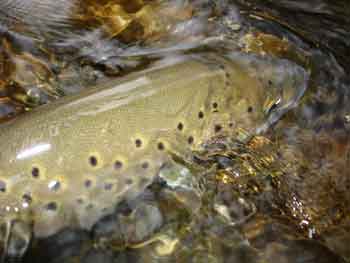
Lenok inhabit the untouched waters deep inside the demilitarized corridor and some of the rivers in South Korea.
THE DMZ of the Korean peninsula has the world’s highest density of landmines. They are estimated to be every 2.3 square meters for a total of 1.2 million, and there is a yearly average of twenty lives claimed by landmines. In April last year, the Donga Daily News ran a photo of soldiers sweeping the Namdae River in South Korea for landmines that were washed away from the annual monsoon season. Between 1996 and 2001, the military removed 1,407 landmines from the riverbanks — something to think about when you are fly fishing in this region.
Most of the landmine victims are either soldiers or farmers. The farmers work inside the Civilian Control Line (CCL), a place where the fieldwork starts at sunrise and the farmers must sign out at checkpoints before dark. Last summer, I received permission to venture into the CCL with a tour group sponsored by the Yanggu County government. The general premise was visiting a scenic waterfall called Dutayeon; my intention was to lay eyes on the headwaters of the Sooip, an untouched stream that holds the highest population of Manchurian trout in the country.
We drove past soldiers clearing brush with rifles slung across their backs and a few farmers worked the terraced rice paddies with small crotch rocket tractors. Mandatory military service is required in South Korea and is a rite of passage for all young men. Holes in the roadside cliffs are spray painted and numbered to show where to insert the dynamite charges to blow a rockslide over the road. In the gravel parking area, we were warned not to wander off the dirt road or path but that was obvious enough since both road and trail were fenced tree to tree with landmine signs. The valley walls were near vertical and thick with pine, fir and Mongolian oak.
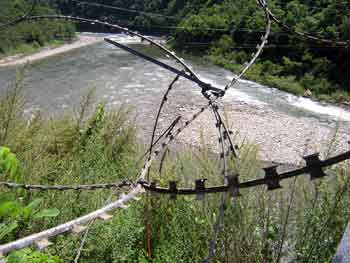
Just being able to view the DMZ rivers that hold Manchurian trout, also known as lenok, requires both official permission and an intrepid spirit.
At the Dutyeon waterfall, the tourist group nodded approval at the pretty scene and snapped pictures with their cell phone cameras even though they were warned photography was prohibited within the CCL. The small waterfall shot down between a narrow gap and formed a massive pool. I, a trout bum in the most heavily militarized strip of real estate in the world, scanned for any riseforms, but it was midday and nothing appeared.
The Manchurian trout, scientifically known as Brachymystax lenok, or just lenok, reaches its southernmost distribution in South Korea. They do not have any migratory characteristics other than descending into deeper water downstream in the dry winters and heading upstream for their spring spawn. On a different and unrestricted stream I scouted last year, I watched them during the spawn and they splashed around like otters, slapping the sides of their body on the surface.
In his book Fly-Fishing the 41st, James Prosek calls them a “fish with an overbite” since the upper jaw extends over the lower jaw. The Korean name for the fish, yeolmokeo, means “fish with heated eyes.” Of the lenok I’ve caught, their eyes never looked especially hot, but rather a golden color around the pupils.
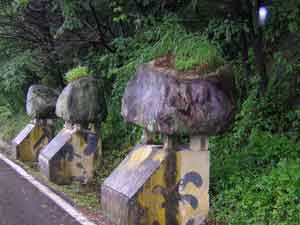
Ironically, tank barriers like these, which are wired to blast huge bolders into the road, have helped preserve the DMZ as Korea's last best hope for biodiversity.
Driving back from Dutayeon, I caught a better glance at the Moondeung Stream that flows into the Sooip. On the banks of the Moondeung there was once a village of lepers. During the war, North Korean soldiers wanted the village destroyed so they reconstructed it into a façade of one of their own military camps and American bombers did the destruction for them. As the bombs fell, legend has it, the lepers jumped into the river and drowned and they turned into lenok whose eyes are bloodshot from weeping.
At the checkpoint of the CCL, I departed from the group and drove over to the Cheonmi Gorge to fish the midsection of the stream. The upper reaches are mintogseon or the “civilian travel restriction zone” and under military control. I parked my car at the entrance of a government sanatorium and bushwhacked down the stream to fish a narrow stretch that requires some rock climbing. The sound of army choppers thumped in the distance and contrails of fighter jets mixed with the clouds. Three hours later, I was still alive, limbs intact, and four lenok took my fly — the one that is loved by all trout worldwide, the parachute Adams.
* * *
The traditional greeting in the DMZ is for soldiers to crouch behind a vehicle barrier and level their K-2 rifles at you. That is only if you get off the beaten path. When I produced my entry permission papers; they loosened up, practiced their English in tidbit conversation and saluted me as I drove past.
I was the only visitor at the Eulji Observatory one afternoon. The ugly cement building sat on the northern ridge of the Haean Basin. During the Korean War, the basin was nicknamed the “Punchbowl,” and was one of the bloodiest fronts of the war. The North Koreans were well dug in and battles were counterattacks composed giving and taking the steep 1,000 meter peaks that form the basin. You can see Heartbreak Ridge and the entrance to the Fourth Infiltration Tunnel, one of three tunnels dug by the North to be used to invade the South for Korean War II. American forces no longer serve on the DMZ and now only have bases in rear positions for more security, mobility and are less hostage to being a “tripwire” that will drag the US into another war.
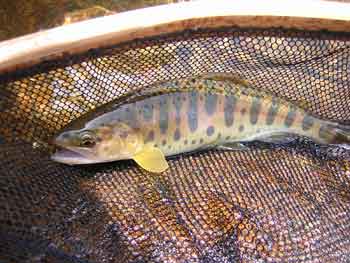
The Masou trout (Oncorhynchus masou), also known as the cherry trout or cherry salmon, is native to the Korean peninsula, Japan and the Russian Far East.
The ceasefire line was drawn at the end of the Korean War in 1953 and created the ultimate oxymoron: the DMZ, the demilitarized zone. The DMZ snakes across the Korean peninsula and effectively turns South Korea into a fortified island. It is two and a half miles wide and 248 miles long and composed of parallel lines — the Civilian Control Line, the southern and northern defense lines, the limit lines of the North and South, and the military demarcation line. Within these boundary lines are fallow rice paddies, ghost towns, relic railways and highways, an ancient fortress, and untouched trout streams — some of which trickle into South Korea.
The DMZ is the Korean peninsula’s last great hope of biodiversity, untouched by the South’s nature-hating industrialization and untouched from the North’s starving, militarized masses. In the center of the DMZ are the Cheolwon Plains, a migratory stop for red-crowned cranes, white-naped cranes, and hooded cranes. Peter Matthiessen described the DMZ as an “accidental paradise” for wildlife in his book Birds of Heaven: Travels with Cranes. The Siberian tiger and Amur leopard, written off to be extinct in South Korea, are given the vague possibility of existence in the DMZ. And they would prey on the trapped populations of wild boar, roe deer, musk deer, water deer and goral, a species of Asian mountain goat.
The landscape is changing. There is more development on the western front of the DMZ since it is closer to the Seoul metropolis. Developers build pre-fab Western-style cabins and villas on the mountainsides and rent them to Koreans that want to pretend they are Americans for a weekend. Public officials trot out the venal word “eco-tourism” in every other press release, with plans to make eco-resort towns, with eco-bridges for eco-roads on eco-theme courses requiring tons of eco-concrete through the region. What nobody likes to talk about is that a true backcountry experience will never be possible with the presence of 1.2 million eco-landmines. South Korea’s environmental groups are addressing these issues and trying to get the DMZ recognized by UNESCO as an ecologically significant site.
* * *
The Seohwa River is a mixed bag of gamefish possibilities. Like some other freestone streams in the province, there were commercial trout fisheries that raised rainbows which later escaped from floods and formed fugitive wild populations to an extent that is hard to judge. Lenok are present, but I’ve concluded that the Seohwa lenok are like New Zealand brown trout — not numerous, but larger in size. While dredging the bottom with a wooly bugger one evening, I caught a Far Eastern catfish, and throughout the waters are Korean brook perch, a kind of miniature smallmouth bass, and the Mandarin fish, a predator perch covered with leopard-like rosettes.
I spent a day on the Seohwa fishing dry flies and caught nineteen dark chubs, as they are called by their common name. Zacco temmincki is a species of the carp family that desperately wants to become a trout but it grows grotesque tubercules around its snout and eyes that takes away from its pretty appearance, like a beautiful cheerleader with warts. Its colors rival that of tropical fish, with peach fins, amber and indigo side and a green back. They are no more than ten inches long and often it seems like you can’t shake them from your hook. After catching nineteen chubs, I saw a large green silhouette swirl up and rise to my Blue-winged Olive and I struck too fast and it disappeared. I cast and set the fly on the same drift and the fish rose and took it. Within a minute I brought in a thirteen inch lenok.
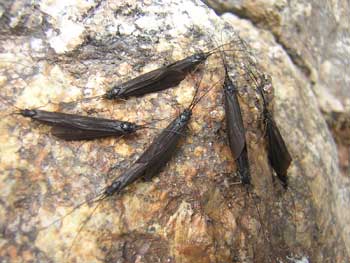
Black caddis cover a rock in the author's favorite Korean river.
In the scattered villages, the shopkeepers at tiny markets sell the ever-present soldiers fake Zippo lighters, olive drab socks, cigarettes, bottles of soju and t-shirts emblazoned with dragons and tigers. School kids that have seen few foreigners before wave and holler “Hello! Hello!” as I pass through the one-street towns. On the numerous hilltops are tank barriers. Some are huge cement blocks propped up to be blasted into the road and impair the forward movement of invading tanks. Others are large boulders with moss and grass growing on top like hair on a head. Each township has a war memorial of some kind, either a large phallic tower that symbolizes an abstract idea, or socialist realism sculptures of war-cry soldiers.
The DMZ doesn’t cut across Korea as a straight latitude line but angles northward to the eastern coast. There is one more road that leads north and that is to the Bouk Stream, which holds a good masou trout fishery. The masou, from its scientific name,Oncorhynchus masou, is also known as the cherry trout or cherry salmon since it migrates to the sea in rivers that are not amputated by dams.The Korean name, sancheoneo, translates to “mountain stream fish,” and they are native to the Korean peninsula, Japan and the Russian Far East. It resembles the Golden trout of California, and that is not so much of a leap if you consider ancient bio-geography and continental drift.
* * *
The Bouk Stream is the northernmost trout stream in the country. It’s the South Korean northwoods, good country, of the kind where I feel at home as an outdoorsman. The city magpies are replaced by crows, wood smoke from the traditional tile roof houses mix with mountain mist, hand-carved jangseung totem poles protect the villages from bad spirits with their contorted faces, and to visit the next village over requires going over a mountain pass loaded with precarious switchbacks. It’s the country’s coldest region and the farm crops of potatoes, sorghum, Chinese cabbages and ginseng are adapted for it.
The rest of the streams of the mountainous Gangwon Province are all to the south. I cut over to the coast and follow seaside Highway 7. The military presence lessens, and there are no more tank traps, but the razor wire still exists and it edges the beaches for miles. The barbed-wire fences are to discourage amphibious infiltrations and watchtowers are every few hundred yards. At one of the beaches, I turn inland and head to my favorite stream.
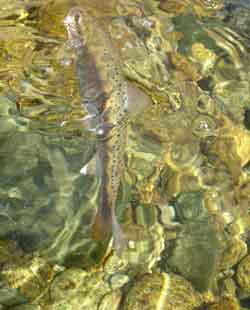
Masou coloration is adapted to the many different waters in northern South Korea, from gorges and caves to tiny pocket water and bright freestone streams.
The fishing starts at a hiking path that leads to a Buddhist hermitage. The trail later deviates from the stream and you’re left with a day of solitude and consistent strikes. It is hours of pocket water under a canopy of trees along banks of rhododendron and there are only eleven spots to extend a backcast, two holes require bow-and-arrow casts, and the rest is roll casting low and tight. Black caddisflies are plentiful, stoneflies come and go and Strigata mayflies are often on the menu, but rarely are the trout picky about what is floating their way.
The creek holds native masou trout and wild rainbow trout from an abandoned commercial fishery. There is a small gorge that either must be waded if water level permits, or you must scale the forested canyon and descend back to the stream. Inside the gorge one can sneak upon and sometimes hook a masou over a foot long. There is more pocket water that leads to a long glide formed by swift flowing bend, and then you see the source of the stream.
The opening of the cave is twenty feet high and it is covered with a metal grid that only a skinny child could enter. I climbed once to the top and peered down. The interior is the size of a living room with a cathedral ceiling and spring water covers the floor a couple feet deep. It’s not much different than the DMZ. It is a wild and unknown place, government controlled — for better or worse, no entrance is allowed — and you cannot explore its secrets. It is enclosed with a steel barrier and the trout beyond have almost never seen a human. A small sign attached to the grid promises punishment for attempting to enter the cave.
At the maw of the cave, I fish the pocket water of tumbled rocks and cast through the lowest steel bars and let the fly drift over a hole. The strike is immediate. Upon inspecting the fish, I see that its colors are darker and the normal olive gold colors have morphed into a brown tint. All of the trout caught near the cave have this coloration. I release the odd-colored trout and it swims back into the fenced-off cave. Like so many beautiful trout streams around the world, the rich waters of the DMZ are both surprising and vulnerable, precariously balanced between the protective and destructive intentions of man.











